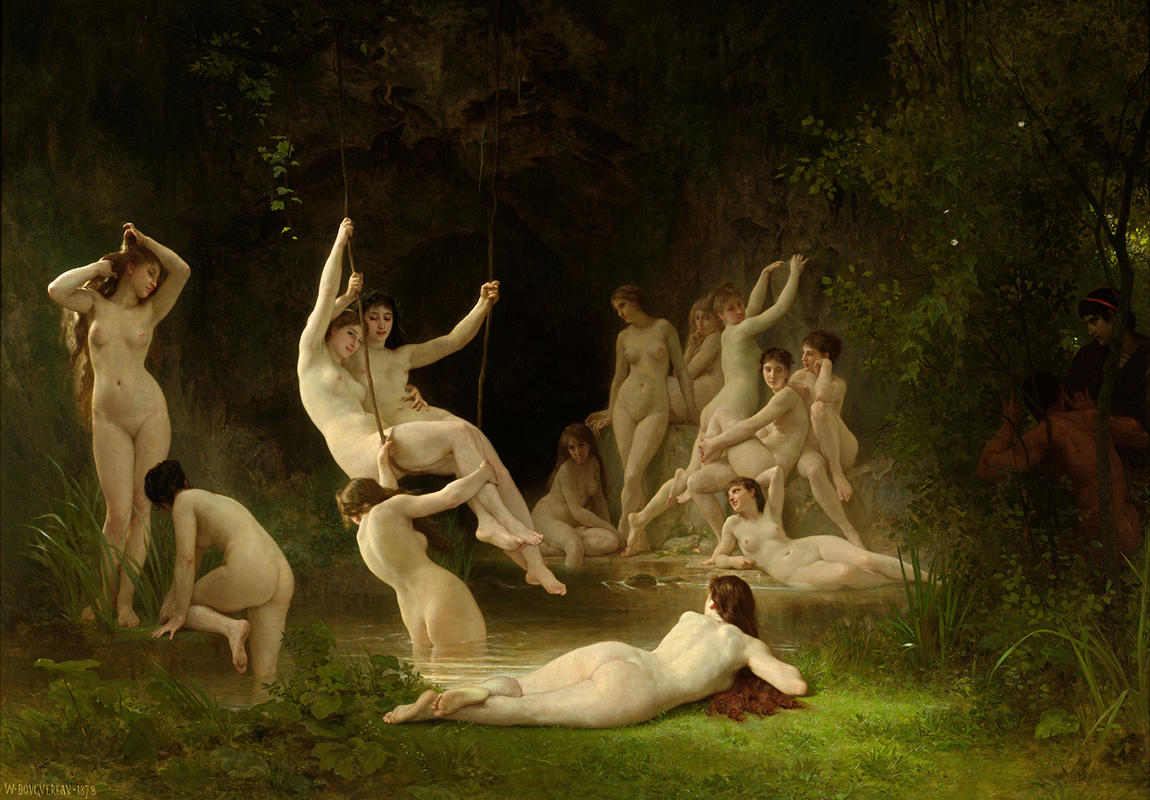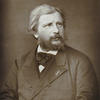More about Nymphaeum

Sr. Contributor
Some artists like to paint landscapes, some specialize in portraits, others may prefer seascapes or abstracts, historical or mythological themes, and countless other subjects. Our man William-Adolphe Bouguereau, though; he was into painting nude women (and at least a few nude men).
He painted them as angels, fairies, mythological figures, allegorical figures, sometimes sitting, sometimes standing: he even painted them swarming up into the sky.
In the 1920s, at least according to a writer for the Chicago Evening Post, Bouguereau’s reputation as an artist in America was largely built upon being a painter of the unclothed body. Not that this was a bad thing in any way; Americans, especially wealthy men (his main clientele), loved his nudes, so this worked out well for everybody. His 1884painting The Bathers went up for auction in 1886, and ended up selling for $18,000, a pretty high price for the time. It was purchased by the owner of a New York tavern, but it’s not known if he hung it up behind the bar or not.
In his 1878 work, The Nymphaeum, the nude women are doing what you do in a nymphaeum: lounging around, playing in the water, giving the other nymphs a bit of side-eye, even swinging on a magically suspended swing. In the ancient Greek and Roman worlds, a nymphaeum was a kind of sanctuary dedicated to water nymphs, with fresh springs and flowing water, as this would be their natural habitat. This term would later be used to refer to man-made grottos and buildings filled with plants, flowers, sculptures, and other works of art. These were used as reservoirs, places of contemplation, and wedding venues. One nymphaeum that is still partially intact is Trajan's Nymphaeum in Ephesus, Turkey; this one was used a public water supply, so no nymphs were in residence here.
Bouguereau produced this work for an exhibition at the Universal Exposition in Paris in 1878. It was exhibited along with twelve other paintings, including allegorical, genre, portraits, and religious pieces; he walked away with a medal of honor for his efforts. And why not, what’s not to like? This work didn’t have just one or two nude nymphs, but thirteen! I wonder if some of the original viewers felt a bit like the two creepers peeking in from the woods (the satyr probably gets a pass here, he’s just doing what satyrs do).
The nymphs and other nudes he painted were sometimes disparaged for being just a little too perfect, looking more like exquisitely carved porcelain or marble sculptures than anything resembling a human figure. Then again, nymphs were not really human, so there’s that. One of Bouguereau’s responses to these criticisms was pretty straightforward: “Why reproduce what is ugly in nature?” Fair enough, although he did regularly use live models in his studio when sketching out the heads and figures in preparation for a full-size canvas. He also compared his figures to “the kind of beauty and impeccable enamel you find in Veronese and Titian,” so we can see he was humble in addition to being a gifted artist.
Sources
- Encyclopedia Britannica, inc. (n.d.). Nymphaeum. Encyclopedia Britannica. https://www.britannica.com/art/nymphaeum.
- Sanders, P. B. (1991). The Haggin Collection. Haggin Museum.
- Scobey, David. “Nymphs and Satyrs: Sex and the Bourgeois Public Sphere in Victorian New York.” Winterthur Portfolio 37, no. 1 (2002): 43–66. https://doi.org/10.1086/376342.
- The nymphaeum - 208.92.96.159. (n.d.). http://208.92.96.159/collections/bouguereau_nymphaeum.shtml.
- Turkish archaeological news. (n.d.). https://turkisharchaeonews.net/object/trajans-nymphaeum-ephesus.
- Werbel, Amy. “The Crime of the Nude: Anthony Comstock, the Art Students League of New York, and the Origins of Modern American Obscenity.” Winterthur Portfolio 48, no. 4 (2014): 249–82. https://doi.org/10.1086/679370.
- William-Adolphe Bouguereau. William Bouguereau. (n.d.). http://www.hoocher.com/William_Bouguereau/william_bouguereau.htm.












… doing what Satyrs do! Indeed!